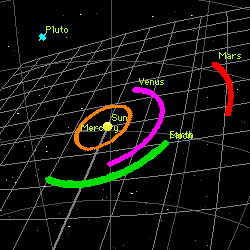SolSys: The Solar System Simulation
 The Solar System Simulation, originated at CONTACT VI in 1987, was developed into an intercollegiate curriculum at Northern Arizona University by Reed Riner, as an honors course in Anthropology and Engineering. Since 1990, it has included student teams from many colleges and universities around the globe.
The Solar System Simulation, originated at CONTACT VI in 1987, was developed into an intercollegiate curriculum at Northern Arizona University by Reed Riner, as an honors course in Anthropology and Engineering. Since 1990, it has included student teams from many colleges and universities around the globe.
The teams represent colonies in a simulated future human community in space. For example, Mars Colony is normally manned by NAU and the Cabrillo College team traditionally inhabits the L-5 Colony near Earth. (See L-5 artwork left by Joel Hagen.) Teams communicate via websites, Internet e-mail and a Multiple User Domain (MUD), a text-based, virtual reality program. Students are directed and encouraged by their local faculty advisors and by a board of professional consultants in the social and space sciences.
 The students build a learning environment in virtual space and explore communication problems in their community of remote "colonies." The computer-supported, interactive virtual reality environment in which the the simulation is conducted can be dramatically demonstrated. An audience visits sites in the future Solar System, where they can tour a city in space, walk on the moon and talk to Martians.
The students build a learning environment in virtual space and explore communication problems in their community of remote "colonies." The computer-supported, interactive virtual reality environment in which the the simulation is conducted can be dramatically demonstrated. An audience visits sites in the future Solar System, where they can tour a city in space, walk on the moon and talk to Martians.
This simulation received national recognition in 1994. A group of federal agencies representing education for the future, including the Coalition for Networked Information and the American Association of Higher Education, selected SolSysSim, out of a wide field of proposals, as one of two projects in the country to be presented at the EDUCOM convention. The judging committee stated that the project "represents best practices in the use of networking and networked information in teaching and learning."
Faculty Advisors & Board of Virtual Consultants
|
|